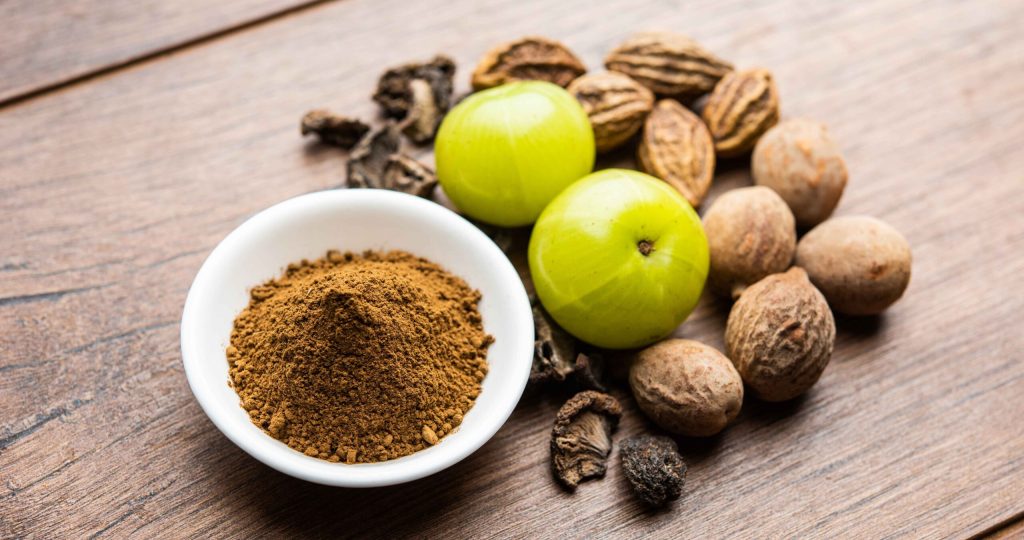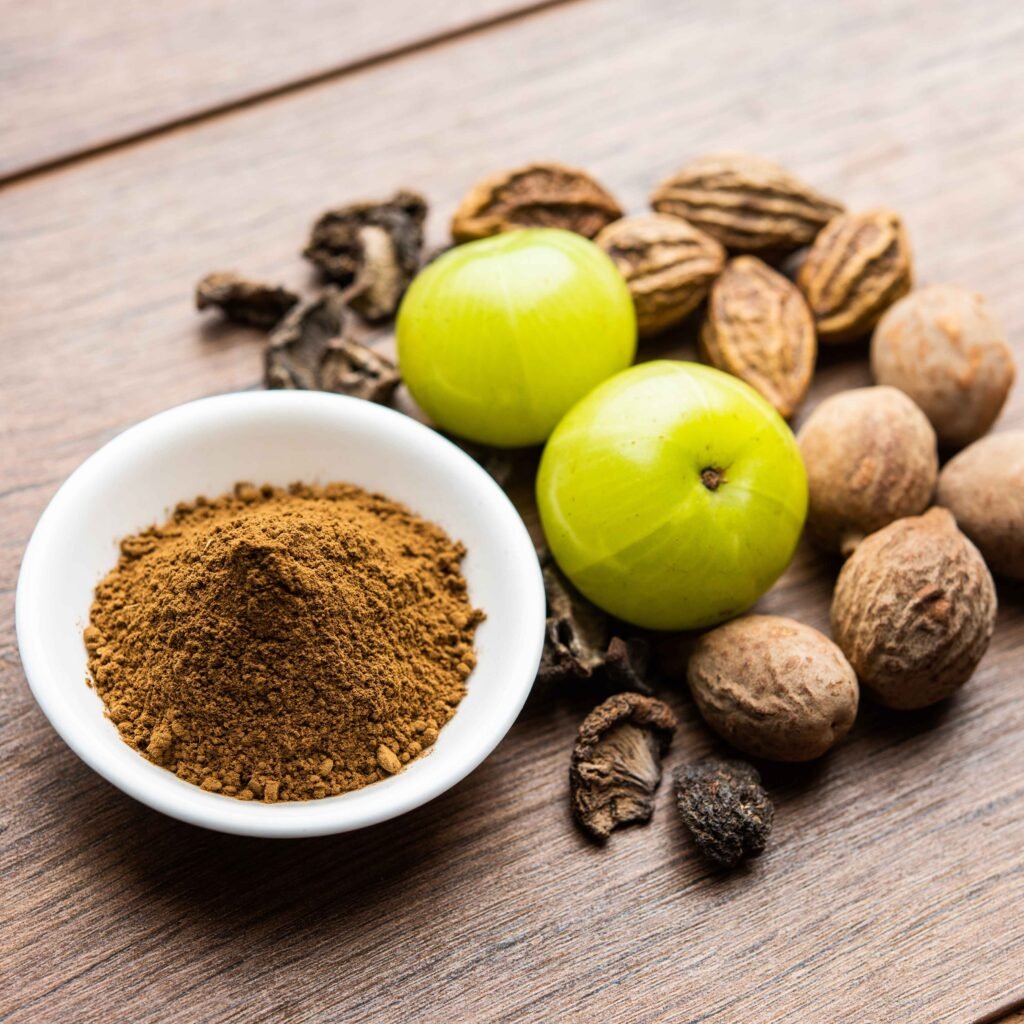Medically Written and Reviewed By: Ayurvedacharya Dr. Gaurav Pathare (BAMS)

Triphala (त्रिफला) is a legendary polyherbal blend in Ayurveda, cherished for its detoxifying, rejuvenating, and healing properties. This ancient remedy combines the dried fruits of Haritaki (Terminalia chebula), Bibhitaka (Terminalia bellirica), and Amalaki (Emblica officinalis) each known for its own powerful benefits. Used for over 3,000 years in traditional Indian medicine, this herbal blend is classified as a Rasayana (rejuvenative tonic) known for promoting overall health and longevity. Modern research has validated its traditional uses, revealing a broad spectrum of health benefits that make it valuable in contemporary wellness practices.
What is Triphala?
One of the biggest misconceptions about Triphala is that it is a single plant. In fact, it is a traditional Ayurvedic formulation made from a blend of three dried fruits: Amalaki (Emblica officinalis), Bibhitaki (Terminalia bellirica), and Haritaki (Terminalia chebula).
Triphala means “three fruits” and is described in classical texts like Bhavprakash:
पथ्याविभीतकधात्रीणां फलैः संयत्र त्रिफला स्मृता ।
फलवृत्तिकां च त्रिफला सा वरा च प्रकीर्तिता ॥
– Bhavprakash
Which means the combination of the fruits of Haritaki (Pathya), Bibhitaka (Vibhitaka), and Amalaki (Dhatri) is known as Triphala. This fruit-based formulation is also called Phalavritti (composed of fruits) and is revered as Vara (the best or excellent one).”
According to tradition, the ideal combination is one Haritaki, two Bibhitaka, and four Amalaki balanced by weight for maximum efficacy. This is explained in the Bhavprakash:
एका हरीतकी योज्या द्वी योज्यी च विभीतकी। चरिाच्यामलकावन च….. ।।
– Bhavprakash
Triphala’s Ayurvedic Profile
Property | Description |
Rasa (Taste) | Five tastes except salty; mainly astringent |
Vipaka | Madhura (Sweet post-digestion) |
Veerya | Ushna (Hot potency) |
Prabhava | Virechana (Mild laxative) |
Dosha Action | Tridoshahara is best for Kapha disorders |
Top Health Benefits of Triphala
त्रिफला कफवातघ्नी मेहकुष्ठहरा सरा ।
चक्षुष्या दीपनी रुच्या विषमज्वरनाशिनी ॥
– Bhavprakash
Which means, Triphala destroys Kapha and Vata doshas.
It is beneficial in Meha (urinary disorders, including diabetes) and Kushta (skin diseases).
Acts as a mild laxative (Sara),
Improves eyesight (Chakshushya)
Stimulates digestive fire (Dipani),
Enhances taste (Ruchya), and
Cures intermittent fevers (Vishamajvara).
Balances Kapha and Vata (कफवातघ्नी)
Triphala helps balance Kapha and Vata, two of the primary doshas in Ayurveda. Excess Kapha leads to heaviness, congestion, and sluggish digestion. Vata imbalance causes dryness, anxiety, and bloating. Triphala’s drying (rooksha) and warming (ushna) qualities counter these imbalances effectively. Its tridoshic nature makes it suitable for long-term, gentle balancing without side effects.
Useful in Meha (Urinary Disorders & Diabetes) (मेहहरा)
The term Meha encompasses a range of urinary issues, including frequent urination and diabetes. Triphala acts as a Pramehaghna, detoxifying urinary channels and improving renal function. It’s bitter and astringent taste tones tissues and helps control sugar metabolism. It reduces excess moisture (kleda) and normalizes urine flow, a key aspect in diabetes care.
Effective in Kushta (Skin Diseases) (कुष्ठहरा)
Triphala cleanses toxins (ama) from the blood and lymph, the root cause of many skin disorders. It is particularly beneficial in chronic conditions like eczema, psoriasis, and even leprosy. Its rooksha (drying) and kledaghna (anti-exudative) actions reduce skin inflammation and discharge. Regular use promotes clear, healthy, and balanced skin from the inside out.
Acts as a Natural Laxative (Saraa – सरा)
Triphala gently stimulates the bowels without causing dependency or dehydration. It supports regular elimination, especially in cases of mild constipation (malavashtambha). Its virechana property helps cleanse the digestive tract and supports detox. Unlike harsh purgatives, Triphala works harmoniously with the body’s natural rhythm.
Improves Vision (Chakshushya – चक्षुष्या)
Triphala is highly valued for maintaining eye health and clarity of vision. Its antioxidant-rich fruits nourish the optic nerves and tissues. Used internally and in formulations like Triphalaghrita, it supports relief in eye fatigue, redness, and infection. In Ayurveda, it is a key remedy for netra rogas (eye disorders), especially with Kapha involve men.
Stimulates Digestion (Dipani – दीपनी)
Triphala kindles the digestive fire (Agni), improving assimilation and metabolism.
Its bitter and pungent tastes reduce sluggishness caused by Kapha. By promoting digestion, it helps prevent the formation of toxins (ama). It is especially effective for those with mandagni (weak digestion).
Enhances Taste Perception (Ruchya – रुच्या)
Loss of taste (aruchi) is often linked to indigestion and toxin buildup. Triphala cleanses the tongue and gut, restoring natural appetite and flavor perception. Its astringent and bitter elements stimulate salivary and gastric secretions. This makes it useful during recovery from illness or post-antibiotic therapy.
Relieves Intermittent Fevers (Vishamajvara – विषमज्वरनाशिनी)
Vishamajvara refers to fevers that come and go irregularly, often due to hidden toxins. Triphala performs pachana (digestive purification) and shodhana (systemic cleansing) of the doshas. It targets the underlying imbalances causing the fever rather than just the symptom. Thus, it supports natural immune function and systemic recovery.
When to take?
To get the maximum health benefits from Triphala, timing, form, and method of intake are crucial and should align with your health goal and dosha balance. Here’s a clear, Ayurveda-based guide:
Health Goal | Best Time to Take | Effect |
Constipation, Detox | At bedtime | Overnight cleansing, gentle laxative |
Weight Loss, Fat Metabolism | Early morning (empty stomach) | Activates metabolism, burns fat |
Eye health, Skin benefits | Consistently at night | Enhances tissue repair overnight |
Diabetes, Blood Sugar | Morning + Night (low dose) | Supports sugar balance and urination |
General Rejuvenation | Daily, the night before sleep | Rasayana (anti-aging) and immunity |
How to Take Triphala
Triphala Churna (Traditional and most effective
Dosage: 1 to 3 grams (¼ to ½ teaspoon)
How: Mix in warm water (Koshnajala) and drink
When: 30 minutes before bed or early morning on an empty stomach
Optional: Add a few drops of honey or lemon if the taste is too bitter
Triphala Vati (Convenient
Dosage: 1–2 tablets (250–500 mg each)
How: Swallow with warm water
When: Same timing as powder, night preferred
Triphala Infusion (Herbal Tea)
Method: Soak 1 tsp. of Triphala powder in a glass of warm water overnight. Strain and drink the next morning.
Benefit: Mild, long-acting detox and weight-balancing effect
Triphala Ghrita (Ghee) – For Eye & Nerve Health
Use: Internally or externally under supervision
Benefit: Soothes eye disorders, nourishes the nervous system
Safe for Regular Use
Yes! Triphala is gentle and non-habit-forming. It doesn’t create dependency like harsh laxatives. But always consult a certified Ayurvedic practitioner for long-term or high-dose usage.
Conclusion: A Must-Have Ayurvedic Superblend
From the ancient Ayurvedic sages to modern wellness enthusiasts, Triphala continues to be a holistic powerhouse for health. Whether you seek detoxification, digestion, glowing skin, better vision, or disease prevention, Triphala has something for everybody’s type (Prakriti). Add this tridoshic marvel to your daily routine and experience the balance of Ayurveda in its purest form.
References
Textbook of Dravya Guna Vidnyan Prof Dr A.P Deshpande Second edition December2007 Mishrak gana page 183 -185
Bali chouhan, Ramesh Chandra Kumawat, Mita Kotecha, A. Ramamurthy, Sumit Nathani. Triphala: A comprehensive Ayurvedic review. Int. J. Res. Ayurveda Pharm. 2013;4(4):612-617 http://dx. doi.org/10.7897/2277-4343.04433
Peterson CT, Denniston K, Chopra D. Therapeutic Uses of Triphala in Ayurvedic Medicine. J Altern Complement Med. 2017 Aug;23(8):607-614. doi: 10.1089/acm.2017.0083. Epub 2017 Jul 11. PMID: 28696777; PMCID: PMC5567597.
Jantrapirom S, Hirunsatitpron P, Potikanond S, Nimlamool W and Hanprasertpong N (2021) Pharmacological Benefits of Triphala: A Perspective for Allergic Rhinitis. Front. Pharmacol. 12:628198. doi: 10.3389/fphar.2021.628198
Tarasiuk, A., Mosińska, P. & Fichna, J. Triphala: current applications and new perspectives on the treatment of functional gastrointestinal disorders. Chin Med 13, 39 (2018). https://doi.org/10.1186/s13020-018-0197-6

